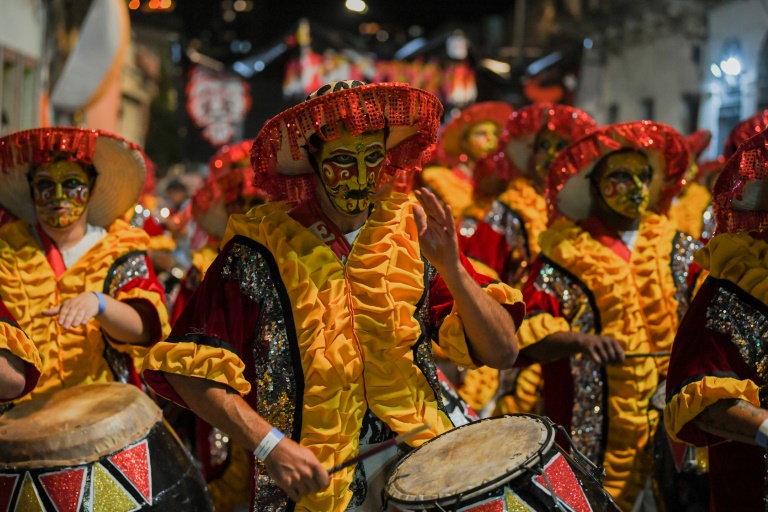
In Uruguay, the Lamada parade or the living heritage of Africa
Cesar Pintos, 86, remembers that as a child he would drum in the streets of his Montevideo neighborhood, beat on tin cans, and sing tunes that his slave ancestors had brought from Africa.
It was in the 1940s, a century after slavery was abolished in the small South American country.
At the time, “candombe”, a typical Afro-Uruguayan drum rhythm, was in full swing.
“Candombe goes back to the time of slavery,” the octogenarian tells AFP of the musical genre classified in 2009 as the Intangible Heritage of Humanity by UNESCO.
He remembers that Africans “brought it with them in their minds, because they did not take any substance. And then it was passed down through families.”
As an adult, César created a “comparsa” (a group) of drums in his neighborhood in Cordon, one of Candombe’s cradles.
As every year, in February the group called Sarabanda participates in “Llamadas” – in reference to the “invitations” made by drummers – an annual parade organized since the 1950s that is one of the highlights of Montevideo’s carnival.
Two evenings in a row, in front of thousands of spectators, the “Comparsas” team of thirty musicians and dozens of dancers in brilliant costumes and make-up compete in competition.
Today, kanombi is practiced by all Uruguayans, black or white, even if its history is intertwined with the struggle for equality among people of African descent.
Cesar Pintos takes great pride in his roots, even if he doesn’t know where his ancestors come from. “According to I, we come from the Congo or Mozambique, but where exactly, we don’t know.”
Montevideo was an important port for slaves to reach South America. At the end of the 18th century, a third of the population was of African descent, according to the municipality.
For generations of slaves and then their descendants, playing the drum made it possible to maintain a connection, even if tenuous, with the African continent.
When slavery was abolished, they created mutual aid societies where Kandombe departed from different African rhythm traditions.
– ‘White country’ –
“The drum for us is key. It allows us to demand and have fun,” says Alfonso Pintos, Cesar’s 59-year-old son who is now the head of Sarabanda.
He recalls, for example, the role of Comársas in protesting against the dictatorship in Uruguay (1973-1984) or the apartheid regime in South Africa.
Today, “Llamadas” are more entertainment, but the fight for more equality is far from over.
“There is always discrimination,” said Thomas Sheremini, 84, president of the Africania Association. “There are many blacks among the poor,” he says.
According to the World Bank, Uruguay in Latin America is characterized by a low level of inequality, although blacks, who represent 8% of 3.2 million Uruguayans, are more likely to be poor.
According to the National Institute of Statistics (INE), in 2014, more than half of Afro-Uruguayans were unable to meet their basic needs, compared to just under a third for whites.
“Uruguay has really taken the idea of becoming a white country very seriously,” explains American historian George Reed Andrews, author of Being Black in a White Country, particularly by encouraging European immigration.
“In their daily lives, many Uruguayans see whites (…) as the norm,” he adds.
In Cesar’s family, candombe is a heirloom. Inside Sarabanda, her grandson, Pablo, 34, leads the drums, and her granddaughter Michaela, 29, leads the dancers.
Catalina’s great-granddaughter, 7, is about to represent the fourth generation.
Among the Afro-Uruguayans, some criticize the fact that the canombe became more commercial with Carnival.
“The most important thing is to be aware of what we stand for when we’re raising our drums,” Fred Barino, 34, a musician from Sarabanda, told AFP.
“We represent everyone who came before us and spilled their blood so we could drum on the street.”

“Hipster-friendly coffee fanatic. Subtly charming bacon advocate. Friend of animals everywhere.”





More Stories
F-16 crashes in Ukraine – pilot dies due to his own error
Namibia plans to kill more than 700 wild animals to feed starving population
Endurance test for EU-Turkey relations and Ankara with Greece and Cyprus